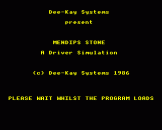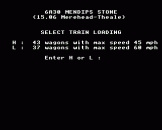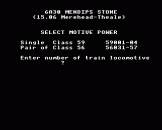Introduction
Several million tons of roadstone material are transported by rail each year from the Mendips Hills in Somerset to processing and distribution centres in London and the South East of England.
One of the major companies involved is Foster Yeoman, who operate a fleet of over 300 privately-owned wagons from their Marehead Quarry complex in the southern Mendips. In a novel move in early 1986 the company imported four General Motors locomotives from the USA specifically to handle their stone traffic on British Rail.
With a special wheel-creep system to improve adhesion, these 3300hp locomotives (designated Class 59 on the BR TOPS system) can single-handedly haul loads in excess of four thousand tons which previously required the rostering of pairs of British Rail's 3250 hp Class 56 heavy freight locomotives. There is however a penalty in slightly increased journey times, and it is to compare locomotive performance that we given you the opportunity to drive Foster Yeoman trains with both types of motive power in this Mendips Stone simulation.
Your Train And The Route
Your train is the 15.06 from Merehead to the stone casting plant at Theale on the West of England mainline between Newbury and Reading. There is a choice of two loadings, one comprising 43 ex-BSC tipplers refurbished by Procor and limited to a maximum speed of 45mph, and the other 37 of the more modern aluminium hoppers manufactured by Procor and permitted to travel up to 60mph. The laden weight of both types of twin bogied vehicle is 102 tons, giving train weights of 4386 and 3775 tons respectively.
The simulation begins with your train having backed out of the quarry sidings up on to the old GWR Witham-Shepton Mallet branch, and then run along what is now the western leg of the Merehead triangle to Quarry Junction which is where the 'chord' arrival line diverges at the head of the single track branch. The line down to Withan is steeply graded, and with heavily laden stone trains care must be taken not to exceed the 15mph branch speed limit.
Once on the main line, however, it is the composition of your train rather than the permitted line speed which will govern your maximum allowed speed. The run from Witham to Westbury is over rather undulating terrain, and then follows a long climb through the Vale of Pewsey to Savernake, before an equally long descent alongside the Kennet and Avon canal to Theale. Signalling throughout is three aspect colour lights, with a typical spacing of 0.9 mils between signals. The main line is essentially double track, with passing/inspection loops at Woodborough and Hungerford.
There is no pre-determined schedule built in to the program, but the omission of the normal crew-changing stop at Westbury running times for the 71 mile journey with no checks should be in the range 110 to 150 minutes, depending on the load and motive power.
Locomotive Controls And Driving Techniques
Details of your locomotives' condition are given along with notification of any permanent way engineering works in the roster notices at the start of the simulation. As you proceed a monitor of the locomotive controls and performance is given in the lower half of the television display, the upper half of the screen containing location data and information a driver would have from visual observations and his background knowledge of the route.
Engine power is governed by a master controller, which in the simulation is graduated with the standard DeeKay Systems six notches ranging from 0 (engine idling and drive disconnected) to 5 (full throttle) rather than being contiuously variable as on the Class 56's or having eight power notches as on the Class 59's. In both types of locomotive current is supplied to the traction motors by an alternator, and to facilitate starting off we just put up a 'high motor current' caption if too high an engine setting is selected at low speed. The Class 59's are of course fitted with the patent radar controlled wheel creep system which gives almost double the adhesion available to conventional locomotives, but as far as a driver is concerned all this works automatically behind the scenes. Once on the move you will find your heavy train sensitive to changes in gradient, but on the whole much more sluggish to respond than with our express passenger simulations, putting a premium on skilful driving.
The brake handle also has six settings from 0 (off) to 5 (full emergency application). With a heavy train of loose stone you should brake very gently, preferably using only the first few notches. As you approach all signals at caution or danger you will receive an AWS (Automatic Warning System) indication on the control panel triggered by track-mounted magnets, and this must be cancelled within six seconds or else there will be a automatic application of the emergency brake. If a signal remains at red as you approach you should bring your train to a halt within 35 yards of it in order to obtain telephone instructions from control about the situation. Similarly at the end of the simulation you should draw up within 35 years of the arrival signal in Theale reception sidings to await unloading instructions.
Game Controls
Controller: > - Increase, < - Decrease
Brakes: X - Increase, Z - Decrease
Space Bar - AWS Cancel
If you want a break during the run, the simulation can be suspended by pressing H (to hold), with action restarted with R (for restart).
Loading
PAGE = &E00
CHAIN ""










